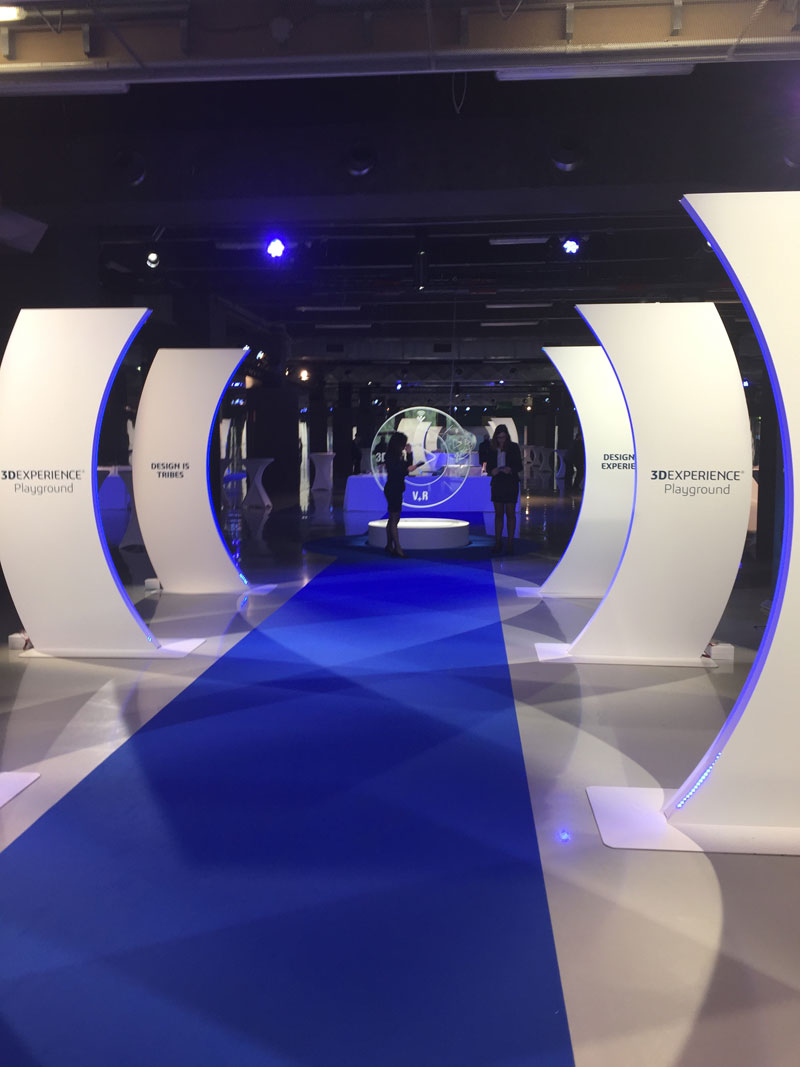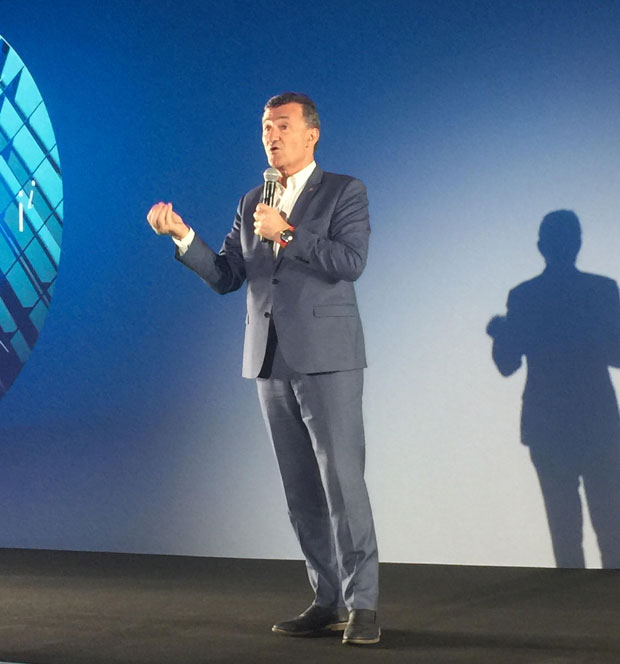
April 9, 2017
Just a few blocks away from where Leonardo da Vinci’s famous painting, The Last Supper, adorns a wall in the convent of Santa Maria delle Grazie and more than 130 models reconstructed from his drawings are displayed in the Museum of Science and Technology, designers and engineers gathered for Dassault Systèmes’ Design in the Age of Experience conference. It kicked off on April 4, during Milan Design Week, when more than 2000 exhibitors from more than 165 countries flock to the city to show off their designs.
Philippe Laufer, CEO of Catia & Gian Paolo Bassi, CEO of SOLIDWORKS tag team on the importance of #3DEXPERIENCE to design. pic.twitter.com/j1UfpowX84
— Digital Engineering (@DEeditor) April 4, 2017
“Milan is the world capital of design, and this is the week of design … there is no better place in the world to discuss the present and future of design to showcase and share with you our vision,” said Gian Paolo Bassi, CEO of SOLIDWORKS as he and Philippe Laufer, CEO of CATIA, took the stage. “What does it take to be leaders in design, in an era of unprecedented changes in both technology and society? Leonardo was a thinker at the intersection of art, science and technology—and it was this mix of elements that created one of the most creative periods in history: the renaissance.”
The 3DEXPERIENCE Vision
Now technology is again driving fundamental changes in the way innovative products are developed. Dassault Systèmes embarked on 3DEXPERIENCE in 2012 as a way to bring the end user’s experience into the design loop across its portfolio of products. All of the big design engineering software players acknowledge that disruptive change is coming to product design, development and manufacturing that is extending digital models and data beyond engineering to enable collaboration throughout the enterprise and beyond. However, all of the big vendors have a different approach to offering solutions to help their customers take advantage of that disruption.
Bernard Charlès, CEO of Dassault Systèmes, summed up his company’s approach when he addressed attendees at the conference:
“Since we announced 3DEXPERIENCE on Feb. 9, 2012 in a one-page document after my board meeting, I said: ‘I’m going to invest all resources that we have—all cash, all talents, all our ecosystem’—not to do more of the past, because the world is sick of doing more of the past,” he said. Speaking of businesses as a whole, he continued: “We are over capacity, we under innovate, and we don’t provide enough value to society. We take too much from mother nature to provide that value. We want to change that equation. That’s the very deep motivation we have at Dassault Systèmes. We can do it because we are not subject to takeover and we can take massive risks to walk away from doing more of the past and doing something very different from anyone else.”
It is indeed a different approach than other vendors are taking. And there is a risk of alienating long-time customers who are accustomed to incremental feature updates to their CAD, simulation and data management software tools. They aren’t accustomed to “harmonizing product, nature and life,” as Charlès described it. Although the 3DEXPERIENCE platform isn’t a tool, or even a suite of tools, all of the design software customers are accustomed to are a part of it. It isn’t a technology like artificial intelligence or 3D printing or augmented reality, though all of those are part of it. Thinking of 3DEXPERIENCE in terms of products and technologies, or even a platform of interconnecting products and technologies is not enough to fully encompass it. It’s also a mission statement to guide future product design and development that is intended to provide the users of those products with great experiences.
The Design in the Age of Experience conference focused on what Dassault Systèmes defines as the four pillars of the 3DEXPERIENCE:
- Designing experience by reducing the distance between the real and virtual experience to zero.
- Design is the business plan because it allows you to reinvent the way you interact with your customers.
- Design is tribes because it must be collaborative and include social elements.
- Design is science-driven that is inspired by the beauty of nature.
Real-World Use Cases
But perhaps the best way to understand the 3DEXPERIENCE is to see how companies are using it to create innovative products and services. At the conference, a number of Dassault Systèmes customers took the stage to discuss designing for experience, including representatives from well-known companies like Nikon, Teague, Ferrari and Honda, as well as young companies like Joby Aviation, Freight Farms, Rimac Automobili and Meta. The speakers focused on what the technology allows them to create, rather than individual features of the software.
Lunar’s John Edson & Simona Maschi from sustainable design think tank CIID address social design. #3DEXPERIENCE pic.twitter.com/rqtXi1DJme
— Digital Engineering (@DEeditor) April 4, 2017
For example, Fiat Chrysler Automobiles (FCA) is deploying Dassault Systèmes’ “Drive Emotion” industry solution experience based on the 3DEXPERIENCE platform. Drive Emotion uses CATIA ICEM applications to help global design teams collaborate in real time on the same virtual model using fully integrated applications to exchange design ideas, according to the company.
According to a company press release: “Drive Emotion delivers a fully immersive, collaborative environment from a design’s initial sketch to its virtual validation. Designers can focus on being creative rather than on the technology to create data. Surfaces are developed in 3D, can be changed easily and rendered immediately, giving designers feedback in real time.
Fossil Group is using the “My Collection” industry solution experience for consumer goods and retail companies, to develop and manage the lifecycles of its products. The company needed a scalable solution to streamline the development of its watch, jewelry and handbag collections while supporting innovation and improving supply chain management to launch products that met consumer demand.
During breaks, attendees were greeted with the 3DEXPERIENCE Playground, a gallery of demonstrations divided among those pillars that leaned heavily toward experiencing design in virtual and augmented reality. Attendees could don a headset to design a handbag, walk through the 3D geometry of an aircraft, sit in a car to get a feel for it and more. Other exhibits included a demonstration of how data flowed from design through to the customer and back to the designer via the 3DEXPERIENCE platform, a topology optimized open source robot that helps people understand the virtual twin concept, and the new 3DPrinting Marketplace by Dassault Systèmes that is now in beta.
[gallery columns=“4” link=“file” ids=”/article/wp-content/uploads/2017/04/3dEXPERIENCE_Playground.jpg|,/article/wp-content/uploads/2017/04/Poppy.jpg|,/article/wp-content/uploads/2017/04/Connectivity.jpg|,/article/wp-content/uploads/2017/04/helmet.jpg|,/article/wp-content/uploads/2017/04/VR_1.jpg|,/article/wp-content/uploads/2017/04/3Dprinting.jpg|,/article/wp-content/uploads/2017/04/holooak.jpg|,/article/wp-content/uploads/2017/04/Pininfarina.jpg|”]
Marketplace as a Future Business Model
The 3DPrinting Marketplace will connect “the industrial ecosystem of designers, engineers and production planners with additive manufacturing service providers,” according to the company. It may be the basis of much more than that. It could be a major part of the company’s approach to cloud computing.
“It’s not limited to 3D printing for sure,” said Pascal Daloz, executive vice president, Brands and Corporate Development for Dassault Systèmes, during a question and answer session with the press. “Our strongest belief—it’s a new business model. When we do cloud, we are still selling a license except that it’s not anymore a license from a pricing standpoint, it’s a subscription. The marketplace could be a way to do it and we could go so far as give the software for free, if we find a way to do that.”
 Bernard Charlès, CEO of Dassault Systèmes, on stage at Design in the Age of Experience 2017.
Bernard Charlès, CEO of Dassault Systèmes, on stage at Design in the Age of Experience 2017.Charlès reinforced the importance of the marketplace concept to the company, which he said they have been testing for five years.
“The marketplace is very strategic, very strategic,” he told the assembled press and analysts. “We will offer much more than 3D printing. We are doing it step by step. We can compute taxes real-time across the globe. It changes the supply chain completely because you basically trade IP and work. It’s a very different model. We are taking it very seriously.”
That drive to innovate and try new things isn’t without its risks. Take da Vinci’s The Last Supper, for instance. The artist, inventor and engineer used a new painting method to give him time to create it the way he wanted it. Unfortunately, that method is one of the reasons the painting began deteriorating almost immediately and has been restored multiple times. Perhaps if he had been able to virtually simulate the long-term effects of adding tempera to dry plaster and painting on a wall coated to absorb the oil paint, he would have been able to solve the problem before putting the first stroke of paint on the wall.
“The beauty of the virtual world is you can see the future without creating it,” Charlès said at the Design in the Age of Experience conference. “We are investing heavily in it.”
Subscribe to our FREE magazine, FREE email newsletters or both!
About the Author
Jamie Gooch is the former editorial director of Digital Engineering.
Follow DE





